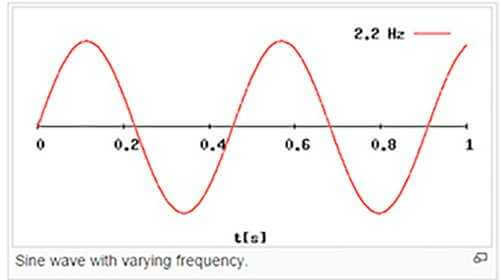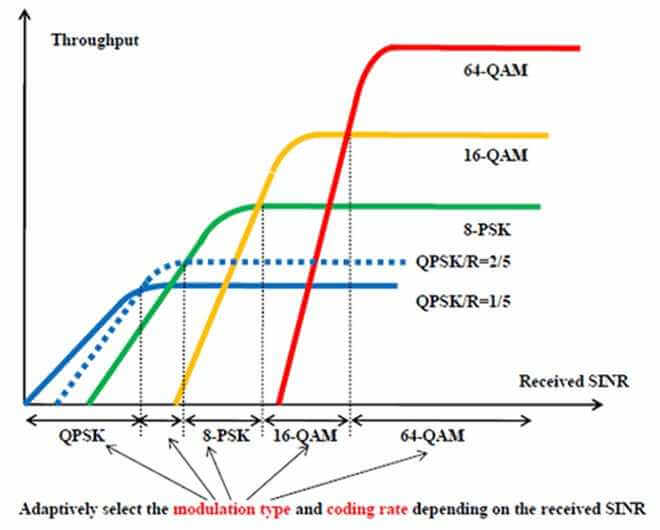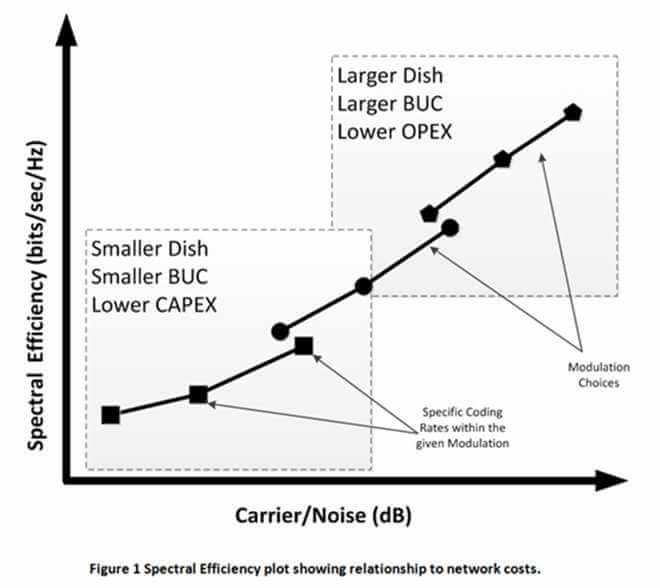Feb 23, 2018
“Just give me a quote,” the client demands, on the phone. “What will it cost?” It seems like a simple question, but the satellite business is a game of trade-offs. For example, why do services from different providers, each advertising the same data rates, often have very different pricing structures? Why might a service provider offer a dedicated circuit at two different prices, and what would account for the difference?
Every satellite service is built with a specific baseline “modcod,” or “MODulation and CODing.” The “coding” part refers to the FEC (Forward Error Correction) overhead. These are redundant bits added to the user’s data that are designed to ensure that traffic is reliably transported from one point to another, by detecting and often correcting errors in the transmission. If the circuit is very robust, fewer FEC bits are required to provide error correction. If the circuit is marginal, more bits are required; otherwise errors may occur, and many packets will need to be retransmitted, thus slowing performance significantly. Consider that broadband satellite communication with GEO (Geosynchronous Earth Orbit) satellites incurs a 2/3 second round trip delay, or latency. When there is an error, requiring retransmission, everything is held up until the packet is acknowledged as having been received properly. If the FEC bits can reconstruct the original data and prevent the retransmission, the service will not slow down as severely. There is a trade-off in performance, because the more bits being used for error correction, the less actual traffic being transmitted.
The other piece of “modcod” is modulation. When sending a piece of digital information over a radio link it must be modulated or changed into an analog signal that can be emitted from the VSAT antenna and transmitted to the satellite spacecraft.
Recall the old days of modem communications when data was sent over standard telephone lines. One would often hear the connection tones of the transmitter and receiver syncing up before the transmission began. The data is in binary form – that is 1’s and 0’s, while the phone line was, and often still is, analog – that is it carries sound waves. The binary digital traffic had to be converted to sounds by the modem, then converted back to 1’s and 0’s at the other end. The process of doing this is called modulation. That is essentially the same mechanism used by wireless and satellite communications today.

Analog communications work by ‘modulating a carrier.’ On telephone lines a sound wave is varied up and down, and this wave is used to transmit information. A satellite signal is somewhat different, but the concept is the same. The order of modulation defines how many bits you can send per each Hz (hertz) or number of cycles per second of radio bandwidth. By modulating and de-modulating analog signals on both ends, you can transmit IP data over satellite. The signal being modulated requires power on the satellite. Depending on the modulation and coding (FEC) options that are selected, the amount of power needed from the satellite changes. What all this means is that satellite operators don’t really sell bandwidth, they sell satellite power, and how that power is converted to bandwidth is what the business is all about.
 Diagram: Arun Agarwal, Kabita Agarwal American Journal of Electrical and Electronic Engineering. 2014, 2(3), 92-97 doi:10.12691/ajeee-2-3-6
Diagram: Arun Agarwal, Kabita Agarwal American Journal of Electrical and Electronic Engineering. 2014, 2(3), 92-97 doi:10.12691/ajeee-2-3-6
The amount of space segment (radio bandwidth) and power required on the satellite spacecraft depends on the amount of IP bandwidth needed, the order of the modulation (4-PSK, 8-PSK, 16-PSK, etc.) and the amount of FEC overhead used. The less FEC overhead and the higher the order of modulation, the less expensive the price per bit of information. A service with a high order of modulation and low FEC overhead will require large antenna and powerful transmitters. For example, a satellite network operator might design a solution that is built using 8-PSK as the baseline modulation and 3/4 FEC overhead, and it will work pretty well anywhere. Another service can be designed to deliver the same number of kilobits, using a higher order 16-APSK as its baseline and only 7/8 FEC overhead. Such a service might appear 30-40% less expensive than the first one, however it will require a larger antenna and a more powerful transmitter at the remote site. If the antenna and transmitter are not properly sized, the transmission power will be insufficient. If the circuit is marginal, then weather conditions over the remote site and/or teleport may result in packet loss, which will slow the throughput or even halt it completely. This will apply in particular to Ku and Ka-band services. The antenna and transmission hardware must be properly designed to support the modulation selected, to optimize throughput and performance.
 Diagram: Impact of RF Equipment on Spectral Efficiency Posted on March 26, 2012 by iDirect
Diagram: Impact of RF Equipment on Spectral Efficiency Posted on March 26, 2012 by iDirect
Some network operators build services with a very high order modulation and low FEC overhead, however in order to reduce startup costs for subscribers, they keep antenna and transmitter, i.e. the BUC (Block Up Converter) smaller than required to support those configurations reliably. Such solutions are attractively priced on paper, however the service will experience frequent slowdowns and disconnections due to changing weather conditions. Similarly, the same “signal fade” problems will necessarily occur if there is a slight misalignment of the antenna at the remote end due to wind, the antenna being bumped, or even ground settling. Cable deterioration (which is natural with time and changing temperatures, especially in extreme heat and cold), water accumulation in the feed assembly, or just about any other phenomena that may occur naturally in the environment with outdoor hardware can affect performance, so a good service provider will build in “margin” to account for these issues. Not having enough power or “link margin” to support the chosen modulation and FEC scheme will generally result in a less reliable solution. As conditions and connectors, etc. deteriorate, a NOC (Network Operations Center) may monitor the reduction in available margin, using an NMS (Network Management System) which will provide notice, that the VSAT at the site should be checked before the margin is gone, and performance starts to suffer or services fail.
BusinessCom Solutions
BusinessCom maintains a specific radio quality standard for commercial iDirect Broadband services. We understand that our clients are located in remote areas; they need dependable connectivity solutions and we know that good engineering assistance is not always immediately available in these locations. We know that if we sell inexpensive services by mismatching modcod and hardware, then our clients will complain that their services are not reliable and will go elsewhere. Turnover or ‘churn rate’ is very high in the VSAT industry and BusinessCom Networks has elected to provide more reliable services in order to minimize this. We back this up in the form of a Service Level Agreement (SLA) that guarantees 99.5% uptime, and we design to deliver that level or better.
For dedicated circuits, we start with the same 99.5% availability as our benchmark, but we are not hobbled by trying to keep the VSAT hardware smaller and more affordable as we are for commercial services. For every client requirement, our NOC engineers conduct an LBA or Link Budget Analysis with the satellite operator. During that procedure our RF engineers determine the best modcod, or modulation and FEC coding required to deliver service with SLA-guaranteed uptime at a specific location, for a specific amount of bandwidth. We will often provide multiple options. If using this set of hardware and this modcod, the MRC (monthly recurring cost) is this much. If larger hardware and more aggressive modcod are used, the MRC is lower. Often a simple one, or two year TCO (total cost of ownership) calculation will show which option makes the most sense.
Doing this successfully, means understanding the capabilities of the various hardware vendors. Vendor A may offer an attractively priced solution that supports a limited set of modcod options, and work with smaller VSAT hardware. Another vendor may offer more advanced modcods that require more expensive modem technology as well as larger VSAT equipment, but the MRC may be significantly reduced, and quickly cost justify the investment in the more advanced hardware.
This subject of modulation and coding is seldom discussed in detail with clients by service providers, but it is a critical factor in the reliability and cost of the services being delivered. When a sales rep is reluctant to provide a quick quote over the phone, there is often a very good reason for it – a reason that will often benefit the client. A little delay to run link budgets and confirm available options is generally worth it, so as to ensure that the best solution has been proposed.





